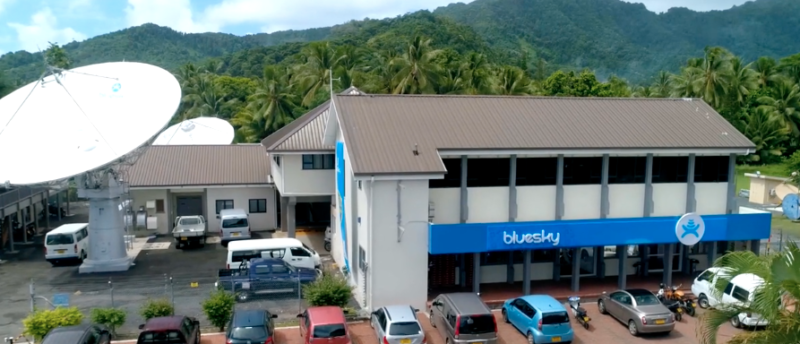Latest News

Teleco Bluesky Cook Islands uses SES’s O3b MEO constellation for a 4G+ network. Photo: SES
The Pacific Islands stand on the cusp of a digital revolution, and mobile connectivity will play a pivotal role in this transformation. Not only will it offer critical access to life-enhancing services such as healthcare and education, but businesses will also benefit from it as a catalyst for innovation and economic growth. Over the past few years, SES’s non-geostationary satellite orbit (NGSO) constellation has been delivering vital connectivity to the Pacific Islands, unleashing an entirely new world of opportunities in this remote region.
The Cook Islands were the first market to use our Medium-Earth Orbit (MEO) low-latency satellite system in 2014 to deliver 3G/4G mobile services. Since then, we have enabled local telco Bluesky Cook Islands to further leverage the O3b MEO constellation to roll out an even faster 4G+ network that provides an enhanced mobile data experience, resulting in better productivity, more business opportunities, and exciting new entertainment options across the islands. This has boosted the tourism sector, which contributes to 70% of the island’s economy. With a population of only 15,000, the Cook Islands now expects to play host to over 170,000 tourists each year.
Elsewhere in the region, we are also witnessing how data connectivity is enabling easy access to essential e-health and e-government services. As an example, Tupaia, a health data aggregation mobile app, has connected and mapped out health services across six countries in the Pacific region, collecting vital data on medicine supply and storage, services, infrastructure, and equipment as well as staff training needs. And PacFarmer, a mobile app targeted at farmers in Fiji, provides access to information on local government support schemes, commodity prices, weather information, and financial services.
The challenges of providing reliable connectivity to outlying islands
The logistical hurdles and the high cost of laying miles of cables for a small resident user base spread across vast oceans in the Pacific, as well as the need for frequent maintenance, has often meant that high-speed internet was not economically feasible for many residents in outlying islands away from population centers.
But that has changed in recent years with the launch of our high-speed, low-latency O3b MEO satellite-based connectivity in the Pacific Islands. The growing demand for connectivity in the region has also resulted in an increase of undersea cable projects to bring high-speed internet to the Pacific Islands.
However, undersea cables are prone to damage caused by accidental cable cuts or natural disasters. Extensive outages can take days and even weeks to resolve, resulting in lost productivity and inconveniences. Last January, connectivity in Tonga was disrupted when an undersea cable was damaged. SES deployed its Signature Telecom Solution swiftly to restore mobile network and broadband access for Digicel customers across Tonga. Unfortunately, connectivity was also disrupted in Papua New Guinea by an earthquake, which caused damage to several nodes of terrestrial and subsea transmission infrastructure. Once again, SES managed to quickly deploy an additional O3b MEO beam to restore network services for affected PNG DataCo customers.
As demand for connectivity grows, relying on a single source of connectivity will not be an option for telecommunication providers in remote areas such as the Pacific Islands. SES provides telcos with resilient connectivity leveraging a multi-orbit fleet of high-performance GEO satellites, low-latency MEO services, advanced ground systems, and a global, IP-based terrestrial network.
Enabling a hyperconnected Pacific
The Pacific Islands have been harnessing the transformative power of connectivity, and are open to embracing technologies such as cloud, the Internet of Things (IoT) and 5G to drive innovation. A hyper-connected Pacific is only attainable if satellite – whether GEO, MEO or the upcoming LEO, when it’s eventually operational – is integrated with other critical elements of digital infrastructure.
In order to achieve this, SES is leading the charge towards seamless integration of our networks into the global connectivity ecosystem by tearing down walled gardens and opening networks with standards-based interfaces. We are further investing in our next generation NGSO communications system, O3b mPOWER to bring more connectivity than ever. We continue to extend our leadership in global network standards bodies and industry organizations. With cloud adoption increasing worldwide, SES is collaborating with cloud service providers such as IBM Cloud and Microsoft Azure to extend the reach of cloud-based applications anywhere in the world, empowering customers to reach new geographic markets and support new applications on the cloud.
With their unparalleled coverage across the globe, satellites continue to act as the critical link bridging remote communities in the world. As countries in the Pacific Islands continue to push ahead with their respective digital transformation journeys, we are proud to continue our support for customers as they bring improved mobile and broadband services to the residents and businesses across the Pacific Islands.

John Turnbull, SES
John Turnbull is the SES Director for the Pacific Region.
Get the latest Via Satellite news!
Subscribe Now